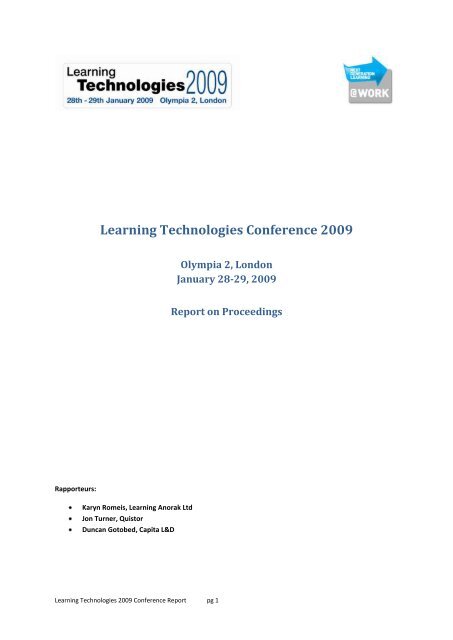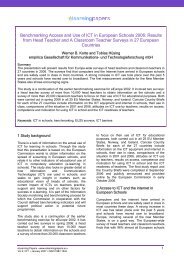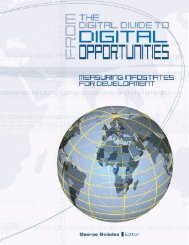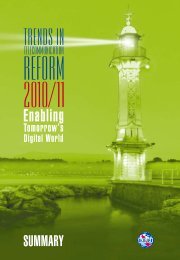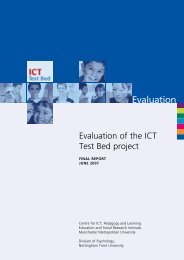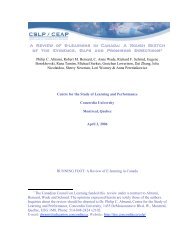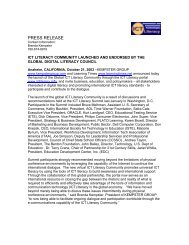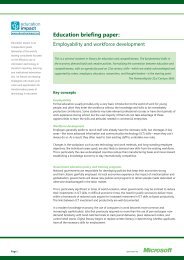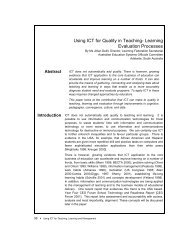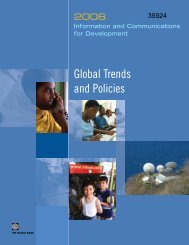Learning Technologies Conference 2009 - ICT Digital Literacy
Learning Technologies Conference 2009 - ICT Digital Literacy
Learning Technologies Conference 2009 - ICT Digital Literacy
Create successful ePaper yourself
Turn your PDF publications into a flip-book with our unique Google optimized e-Paper software.
<strong>Learning</strong> <strong>Technologies</strong> <strong>Conference</strong> <strong>2009</strong><br />
Olympia 2, London<br />
January 28-29, <strong>2009</strong><br />
Report on Proceedings<br />
Rapporteurs:<br />
Karyn Romeis, <strong>Learning</strong> Anorak Ltd<br />
Jon Turner, Quistor<br />
Duncan Gotobed, Capita L&D<br />
<strong>Learning</strong> <strong>Technologies</strong> <strong>2009</strong> <strong>Conference</strong> Report pg 1
Introduction<br />
The <strong>Learning</strong> <strong>Technologies</strong> <strong>Conference</strong> <strong>2009</strong> was our tenth. It had a record number of delegates and a great<br />
buzz as <strong>Learning</strong> and Development practitioners from around the UK and beyond gathered to share their ideas<br />
and experiences. To capture the delivery part of the conference, a rapporteur attended every session. The<br />
result is this report, which both serves as a record in its own right and a jumping off point for the videos of the<br />
sessions.<br />
The three rapporteurs deserve our thanks for this great volunteer effort, and for capturing the essence of a<br />
meeting at a time when one decade of our profession is ending, and a potentially very different one beginning.<br />
Donald H Taylor, <strong>Conference</strong> Chairman<br />
Contents<br />
Introduction ....................................................................................................................................................... 2<br />
Keynotes: ............................................................................................................................................................ 3<br />
Opening keynote: <strong>Learning</strong> and development: intellectual capital you can bank on ...................................................... 3<br />
Keynote: <strong>Learning</strong> and Technology: success and strategy in a digital world .................................................................... 3<br />
Closing keynote: <strong>Learning</strong> for tomorrow: what a difference a decade makes ................................................................. 3<br />
Track 1: <strong>Learning</strong> Technology ............................................................................................................................. 5<br />
Session 1: <strong>Learning</strong> technologies: the road ahead ........................................................................................................... 5<br />
Session 2: 3D learning and virtual worlds ........................................................................................................................ 5<br />
Session 3: Social media and learning ............................................................................................................................... 5<br />
Session 4: The future of learning and content management ........................................................................................... 6<br />
Session 5: <strong>Learning</strong> 2.0 in the real world ......................................................................................................................... 7<br />
Track 2: <strong>Learning</strong> in Practice .............................................................................................................................. 8<br />
Session1: Choosing the right tools for the job ................................................................................................................. 8<br />
Session 2: Next generation L&D in the workplace ........................................................................................................... 8<br />
Session 3: Designing e-learning with the learner in mind ................................................................................................ 8<br />
Session 4: Embracing new technology to reach widespread learners ............................................................................. 8<br />
Session 5: Rapid development in the real world .............................................................................................................. 9<br />
Track 3: <strong>Learning</strong> Strategy ................................................................................................................................ 10<br />
Session 1: Building learning strategy and culture .......................................................................................................... 10<br />
Session 2: Talent and competency based learning ........................................................................................................ 10<br />
Session 3: Aligning learning to strategic objectives........................................................................................................ 11<br />
Session 4: Growing the L&D function ............................................................................................................................. 11<br />
Session 5: <strong>Learning</strong> engagement in the real world ........................................................................................................ 12<br />
Online Reaction to the <strong>Conference</strong> .................................................................................................................. 14<br />
The Rapporteurs ............................................................................................................................................... 13<br />
<strong>Learning</strong> <strong>Technologies</strong> <strong>2009</strong> <strong>Conference</strong> Report pg 2
Keynotes:<br />
Opening keynote: <strong>Learning</strong> and development: intellectual capital you can bank on<br />
Speaker: Tony Buzan, author, educationalist, creator of Mindmapping ®<br />
Key messages: nurture your brain, help people to invest in theirs and be ready to take the opportunities it will<br />
bring<br />
Tony stressed that we are living in a paradigm shifting age that requires the development of multiple<br />
intelligences. He pointed to research on creativity that suggests that people’s creative ability reduces as we<br />
progress through the educational system. While these results have been replicated globally, they do not<br />
indicate a natural state of play as we use less than one percent of our creative potential. He argued that L&D<br />
needed to develop their organisation’s intellectual capital through helping people to invest in their brains and<br />
to develop the skills of creativity. This can only be done by ensuring people work in a supportive environment<br />
and have the opportunity to learn and to make connections. (DG)<br />
Keynote: <strong>Learning</strong> and Technology: success and strategy in a digital world<br />
Speaker: George Siemens, University of Manitoba<br />
Key messages: L&D professionals must understand that they are involved in information shaping; we must<br />
broaden and clarify our vision; the ROI criteria have changed.<br />
George spoke for forty densely packed, PowerPoint-free minutes without hesitation, deviation or repetition,<br />
but with a fair amount of wry humour! He traced the evolution of the management of information, in<br />
particular in the field of PR, and drew parallels and lessons for the field of L&D. Echoing Tony Buzan, he talked<br />
of how L&D was moving towards the management of the management of learning, towards a society of weak<br />
links and quick connections. The quantitative change in the volume and speed of information available brings<br />
its own qualitative change: more, as George says, is different. Questions at the end included this: does this<br />
change mean that L&D is moving from a production to a custodial role? (KR)<br />
Closing keynote: <strong>Learning</strong> for tomorrow: what a difference a decade makes<br />
Speakers: Donald Clark, Ufi; Jay Cross, Internet Time Group and Charles Jennings, Duntroon<br />
Key messages: The global economy is in survival mode, to survive we need to look back at social networking as<br />
well as forwards; We have the tech, now how do we use it? The culture must switch from training to<br />
performance<br />
Jay opened with his inimitable enthusiasm about the past ten years of development. He suggested that we<br />
consider throwing away our 3/5/10 year strategies for e<strong>Learning</strong>. How do we know if informal learning is good<br />
enough? If its good enough for Obama its good enough for you. Jay also mentioned how he plans to bring<br />
together non-L&D specialists at www.learningirregulars.com.<br />
Charles introduced the German concept of ‘Fachidiot’ – or one trick pony. Having a single solution to a training<br />
need is no longer an option. Charles asked: Has anything in training actually changed in the last 10 years?<br />
<strong>Learning</strong> is about behavioural change, not passing assessments.<br />
<strong>Learning</strong> <strong>Technologies</strong> <strong>2009</strong> <strong>Conference</strong> Report pg 3
Donald. <strong>Learning</strong> and technologies clash. Impassioned chat about new technologies getting smaller, cheaper,<br />
wireless and better. The same should be the case for e<strong>Learning</strong>. We as L&D professionals can learn a lot from<br />
the technological developments over the past 10 years. Catch phrase: ‘How great is that?’<br />
Don asked the panel to provide one great example of inspirational e<strong>Learning</strong>:<br />
Donald – Caspian <strong>Learning</strong> – 3D gaming/learning software<br />
Charles – Sun learning exchange – Corporate YouTube<br />
Jay – Cisco – collective responsibility for projects (JT)<br />
<strong>Learning</strong> <strong>Technologies</strong> <strong>2009</strong> <strong>Conference</strong> Report pg 4
Track 1: <strong>Learning</strong> Technology<br />
Reviewed by Jon Turner, Quistor<br />
Session 1: <strong>Learning</strong> technologies: the road ahead<br />
Key messages: Technology & access are now ubiquitous; Informal learning should not be<br />
contained/tracked/managed<br />
Speakers: Seb Schmoller, ALT and Jay Cross, The Internet Time Group<br />
Seb introduced his talk by explaining the falling cost of processing power and the ubiquity of technology.<br />
‘Phones are becoming like PCs only with more stuff on them.’ Almost 50% of the world’s population have a<br />
mobile phone. A head of steam is developing behind open course content however Seb did temper this with<br />
the fact that open source is not necessarily the panacea for learning. He ended on a sobering note that<br />
learning technologies have been with us for a fraction of the existence of human beings and the internet<br />
changes nothing fundamental about how our mind work.<br />
Jay opened the talk by asking the delegates to login to the backnoise.com website and contribute to the<br />
session via their laptops. Flow.informl.com was shown as an information aggregator – an excellent tool for<br />
informal learning. Other aggregator tools shown were: Friend feed, Tumbler, Mimio, Veodia and Scribd. The<br />
point he was making is that there are literally thousands of new social media tools around, it is difficult to keep<br />
up and near impossible to find time to access and use these tools. Intelligent aggregators of these tools help to<br />
personalise, speed up and centralise. Questions were raised about barriers to the use of new technologies and<br />
who takes responsibility for the learning with ‘informal learning’, the answer from Jay was in essence build it<br />
and they will come.<br />
Session 2: 3D learning and virtual worlds<br />
Key messages: Just because we can it doesn’t mean we should; Collaboration in 3D virtual worlds is useful for<br />
contextual scenario based learning<br />
Speakers: Steve Prentice, Gartner and Ron Edwards, Ambient Performance<br />
Steve explained that it is essential to identify your objectives before the ‘cool’ technology. Second Life is not<br />
very enterprise friendly (firewall, client size issues etc.) however there are corporate virtual worlds but all<br />
require time to get used to the environment. Skills learnt in gaming environments are transferrable to your<br />
working life – decision making, problem solving, social interaction etc. If context & location is important then<br />
3D virtual worlds will help. The future for learning, according to Steve will be browser based virtual<br />
collaboration.<br />
Ron demoed the Forterra 3D world environment online using a PowerPoint presentation example delivered in<br />
front of a group of avatars followed by ‘teleporting’ to a virtual shop for a scenario. It showed that online<br />
collaboration can be an effective method of training for widely dispersed audiences, particularly for scenario<br />
based learning where learners can view the scenario and provide feedback/answer questions from the<br />
instructor.<br />
Questions from the floor were posed directly to the avatars, bypassing Ron.<br />
Session 3: Social media and learning<br />
Key message: Social media for learning is all about sharing knowledge with others, not training. See<br />
www.c4lpt.co.uk for a guide to social media; Employees are voting with their feet in favour of access to social<br />
media tools<br />
<strong>Learning</strong> <strong>Technologies</strong> <strong>2009</strong> <strong>Conference</strong> Report pg 5
Speakers: Jane Hart, C4LPT and Andy Tedd, Consultant<br />
Jane is a social media expert. She started with stating that social media tools tend not to have a coherent<br />
strategy behind them. She suggested using the social media & learning group site to continue a discussion<br />
initiated at LT. iGoogle was singled out as an effective aggregator for many social media tools. Social media<br />
tools help to create ‘Personal <strong>Learning</strong> Environments’ (PLEs) for informal learning.<br />
Jane described how she is working with the University of East London to develop a social media system to<br />
provide both a formal and informal environment for their learners using the open source Elgg.<br />
Andy opened his session with some surprising statistics on the amount of social networking generated by<br />
Obama and went on to discuss how to raise corporate usage of social media environments by addressing the<br />
generations; Y are now the consumers, X are the implementers and the baby booming generation are the<br />
decision makers for social media. Highest trusted source is ‘a person like yourself’, not a CEO who writes a<br />
blog!<br />
Session 4: The future of learning and content management<br />
Key message: Do we as L&D professionals need/want/have to manage learning? Reuse, reduce, in-source and<br />
collaborate for effective content design<br />
Speakers: David Wilson, Elearnity and Lt Cdr Paul Pine, Royal Navy<br />
David used the ‘Meet Charlotte’ video to demonstrate that information is far more easily accessible from<br />
outside the office (fire)walls. Some business drivers/key processes for the traditional LMS are still applicable to<br />
<strong>Learning</strong> 2.0, particularly contextualised search, some are new such as mobility, learner networks,<br />
personalisaton, peer review. The key shift with 2.0 is from push to pull learning. David’s concern is the lack of<br />
interoperability between LMS 2.0 tools and enterprise 2.0 tools. There needs to be an informal learning<br />
structure that informs the formal learning strategy.<br />
Paul described how the brand new destroyer required a brand new approach to training. Previously, multiple<br />
training centres developed e<strong>Learning</strong> in silos. 50+ courses were required. A LCMS was used to enable<br />
collaborative development and content reuse. Paul mused that if you are firing a weapon, the Navy don’t want<br />
them to have been trained via Wikipedia and therefore need a more formal and quality assured training<br />
environment.<br />
<strong>Learning</strong> <strong>Technologies</strong> <strong>2009</strong> <strong>Conference</strong> Report pg 6
Session 5: <strong>Learning</strong> 2.0 in the real world<br />
Key message: <strong>Learning</strong> 2.0 is the read/write/learn revolution; Change or die; Is there a future for face-to-face<br />
conferences like LT in the light of 2.0?<br />
Speakers: Barry Sampson, Web Based Thinking, Kate Day, Cisco Systems and John Castledine, Pfizer Global<br />
R&D<br />
Barry kicked off with what he wished he’d known 10 years ago (how to type). e<strong>Learning</strong> content is an anomaly<br />
in learning as it does not allow collaboration. Facebook and other 2.0 tools are being used whether endorsed<br />
or not.<br />
Kate described the need to move from being learning professionals into being communication experts. The<br />
internet is less about the network of computers, more about the network of people. Multi-generational<br />
workforce challenges require relevant training strategies.<br />
John pointed out that LT delegates are the early adopters and provide knowledge on <strong>Learning</strong> 2.0 tools. Less<br />
than 10% of people will make life changes when faced with life threatening situations so how can we expect<br />
them to make work changes willingly? Pfizer has adopted their Wiki as the primary on-line comms tool.<br />
Another Pfizer initiative “Its my life’ helped employees to learn to learn.<br />
<strong>Learning</strong> <strong>Technologies</strong> <strong>2009</strong> <strong>Conference</strong> Report pg 7
Track 2: <strong>Learning</strong> in Practice<br />
Reviewed by Karyn Romeis, <strong>Learning</strong> Anorak<br />
Session1: Choosing the right tools for the job<br />
Key message: Make sure you’re well informed!<br />
Speakers: Gordon Bull, <strong>Learning</strong> Forte and Mark Berthelemy, Capita L&D<br />
Gordon reminded us that selecting a technology is not one decision, but a series of decisions. He urged us to<br />
make these in concert with other departments, first identifying the real issue in the context of the business<br />
itself, before starting down the road to identify the solution (which may not include learning intervention at<br />
all).<br />
Mark gave us five key questions to ask before implementing an open source option:<br />
1. Will it do the job?<br />
2. Will it fit?<br />
3. What will it cost to implement?<br />
4. Where will we get support?<br />
5. Does it have a sustainable business model?<br />
He followed this up with a few useful pros and cons to the open source model as opposed to proprietary<br />
software.<br />
Session 2: Next generation L&D in the workplace<br />
Key message: Choose the right delivery medium for the situation<br />
Speakers: Sue Farrow, Xerox Ltd and Bernadette Ude, Finning Group UK<br />
Sue described a five-stage, blended learning intervention rolled out at Xerox to support a change process. It<br />
was a mandatory, top-down solution aimed at decreasing ‘nudge learning’ from neighbours.<br />
Bernadette, described the implementation of an electronic performance support system at Finning. This was<br />
aimed at taking just-in-time support and learning to the learner, empowering and enabling them at point of<br />
need.<br />
Session 3: Designing e-learning with the learner in mind<br />
Key message: Make it easier for the learner to recall information<br />
Speaker: Itiel Dror, University of Southampton<br />
Itiel delivered both talks in this session, stressing the importance of memory to learning.<br />
In the first session, he described a research experiment which sought to identify factors (of both the learner<br />
and the design of the elearning) which promoted and hindered recall of material.<br />
His second session demonstrated some examples of interactive video and provided some useful tips on<br />
creating similar materials.<br />
Session 4: Embracing new technology to reach widespread learners<br />
Key message: Harness the tools and technologies that are already in general use<br />
Speakers: Maj. Roy Evans, British Army and Kirstie Donnelly and Deborah Prynne, learndirect<br />
<strong>Learning</strong> <strong>Technologies</strong> <strong>2009</strong> <strong>Conference</strong> Report pg 8
Roy has the enviable job of ‘playing with things’ to explore their potential as learning tools. He described the<br />
use of the iPod and Nintendo DS to deliver low level language and numeracy learning to soldiers ‘in theatre’.<br />
The success of the initiative is evidenced by the user demand for further materials.<br />
Kirstie and Deborah described how learndirect (like the conference itself, celebrating its 10 anniversary this<br />
year) had opted to mirror what users were already doing online by opting for a Facebook-esque interface,<br />
embedding a range of fit-for-purpose assets, including where appropriate, pdf documents.<br />
Session 5: Rapid development in the real world<br />
Key message: Rapid does not mean poor<br />
Speakers: Nick Shackleton-Jones, BBC T&D; Gareth Wellings, Deloitte and Anthony ‘Skip’ Basiel, Middlesex<br />
University<br />
Nick and Gareth shared case study experience from their respective organisations. Skip then highlighted some<br />
of the paradigm shifts needed for the effective implementation of rapid learning within an organisation. A few<br />
people were startled by his use of the term ‘ultra rapid’ when they had yet to come to grips with ‘rapid’. This<br />
session is probably best captured by some of the questions raised and discussed from the floor:<br />
How rapid is rapid?<br />
How big is a rapid development team?<br />
Is it possible to outsource just certain elements of a rapid development project, and if so, which?<br />
How do you deal with maintenance?<br />
Discussions such as these should be continued on within the Ning community.<br />
<strong>Learning</strong> <strong>Technologies</strong> <strong>2009</strong> <strong>Conference</strong> Report pg 9
Track 3: <strong>Learning</strong> Strategy<br />
Reviewed by Duncan Gotobed, Capita L&D<br />
Session 1: Building learning strategy and culture<br />
Key message: the world is changing, L&D needs to build a strategic value for the organisation by solving<br />
managers’ problems and engaging learners<br />
Speakers: Charles Jennings, Duntroon and Sharon Claffey Kaliouby, Enterprise Island<br />
Charles reinforced the idea that organisations are moving into a new age and as a consequence <strong>Learning</strong> and<br />
Development needs to focus on building strategic value by enabling growth acceleration, transformation and<br />
increased productivity. He suggested this can be done through:<br />
Aligning with business needs by being business driven<br />
Building the capability of L&D professionals to deliver the promise<br />
Using the right technology to achieve the desired results<br />
Sharon highlighted that developing a learning culture is a long journey that begins with small steps. She<br />
suggested that the best way to get Senior Management buy-in and endorsement is through aligning with the<br />
strategic needs of the business. Sharon also explained the importance of engaging with people, helping them<br />
to solve their problems, listening to what they want, delivering on your promises and ensuring that the<br />
learning people have undertaken is valued.<br />
Discussion areas included<br />
Age differentiation<br />
Tech savvy L&D professionals<br />
Aligning with directionless organisations<br />
Session 2: Talent and competency based learning<br />
Key message: talent management pays, HR needs to be strategic and evaluation matters<br />
Speakers: Alan Hewitt, IBM and Lara Taylorson and Alison Maher, TfL<br />
Alan defined talent management as having the right people, with the right skills and motivation, the right<br />
information, in the right roles and at the right cost so that they deliver value in a sustainable way. He explained<br />
HR has an important strategic role to play in talent management by sourcing, deploying and leading/managing<br />
people effectively. This can be achieved by evaluating where the capability gaps lie in the organisation, what<br />
the pivotal roles are and how well the organisation retains people.<br />
Lara and Alison talked about ‘Project Pyramid’, which was concerned with building programme and project<br />
management capability in TFL. It covered three main areas:<br />
Developing a competency framework that was benchmarked externally<br />
Designing and procuring an online tool that helped people to identify what they needed to focus on and<br />
pointed them in the direction where they could address the skills gap<br />
Building a learning and development portfolio that addressed people’s needs<br />
Key success factors of the programme included involving the programme management community in each<br />
stage of the training cycle as well as working with other TFL L&D offerings.<br />
<strong>Learning</strong> <strong>Technologies</strong> <strong>2009</strong> <strong>Conference</strong> Report pg 10
Discussion areas:<br />
Assessment tools<br />
Senior level buy-in<br />
Competencies<br />
Session 3: Aligning learning to strategic objectives<br />
Speakers: Nigel Harrison, Chartered Business Psychologist and Jim Fingland, City of Edinburgh Council<br />
Nigel described the importance of having a structured diagnostic conversation with the client. The problemsolving<br />
process involves getting the client to talk about the problem so you can find out what is currently<br />
happening, what they would like to happen and the cost of doing nothing. This then allows you to focus on the<br />
solution and what needs to happen in terms of knowledge, skills, motivation and environment.<br />
Jim highlighted the benefits of using a single competency framework, focused on key behaviours. He described<br />
how the Council identified a partner to develop an LMS based on the competency framework and created a set<br />
of resources for managers and professionals to access. Jim also emphasised the importance of focusing on<br />
metrics to evaluate the impact of <strong>Learning</strong> and Development on the organisation.<br />
Discussion areas:<br />
Using a single set of competencies<br />
Session 4: Growing the L&D function<br />
Key message: build in additional time for the unexpected, build an effective team and keep it together and<br />
use technology smartly.<br />
Speakers: Gail Sadler, Hilton Hotel Corporation and Mike Cawood, BP International<br />
Gail described the lessons she learnt from implementing a successful, international e-learning project. These<br />
included building additional time into the project plan as SMEs were not always accessible and vendors took<br />
longer than expected to get the content back. She also highlighted the benefits of maintaining the team for the<br />
duration of the project and sharing key deliverable with stakeholders so that everyone sees the big picture.<br />
Mike described the importance of harnessing technology and people to overcome barriers. He highlighted the<br />
benefits of having tech savvy learning professionals who are good communicators, a trusted set of vendors<br />
and suppliers and SMEs who are clear on what is expected of them. In terms of technology, Mike emphasised<br />
the need to take into account the organization’s IT landscape and to leverage rapid development tools to<br />
respond quickly to what the business wants.<br />
<strong>Learning</strong> <strong>Technologies</strong> <strong>2009</strong> <strong>Conference</strong> Report pg 11
Session 5: <strong>Learning</strong> engagement in the real world<br />
Key message: align with the organization’s needs, use people and policy to support e-learning, treat a launch<br />
in the same way as a product launch<br />
Speakers: Laura Overton, Towards Maturity; Jon Aveling, NCALT and Zbigniew Wojciech, Toyota Motor<br />
Europe<br />
Laura reinforced a common theme, within the <strong>Learning</strong> Strategies stream, which was to align e-learning with<br />
both business and individual learners needs. She also highlighted the importance of taking into account the<br />
work context and actively engaging stakeholders, which was developed by Jon Aveling.<br />
Jon explained how a protected learning policy enabled NCALT e-learners to access e-learning from home and<br />
at work. He also highlighted the importance of gaining strategic support from senior management and IT by<br />
embedding e-learning in the training strategy and getting the right people to talk to each other. Negative,<br />
anecdotal stories of e-learning were actively countered by a learning outreach team,<br />
Zbigniew then explained some of the approaches that were used by Toyota to achieve high e-learning<br />
adoption rates. These included treating the e-learning roll out with the same attention to detail as a car<br />
launch. Adapting to local conditions, providing feedback to managers on usage and ensuring e-learning was<br />
released in a timely fashion.<br />
<strong>Learning</strong> <strong>Technologies</strong> <strong>2009</strong> <strong>Conference</strong> Report pg 12
The Rapporteurs<br />
Karyn Romeis<br />
Self-confessed learning geek, Karyn has been in the field of L&D in a variety of roles for over 20 years. She<br />
attributes her success during her years as a classroom based trainer in no small part to her early stage career.<br />
She has worked with and for a range of organisations of various sizes, sectors and countries.<br />
She is a keen user of social media and is a vocal member of several online communities of practice, where she<br />
is known for speaking her mind.<br />
She is passionate about learner engagement and empowerment, which are among the watchwords of her<br />
independent L&D consultancy, <strong>Learning</strong> Anorak Ltd, established in 2008. Prior to that, she worked as a<br />
<strong>Learning</strong> Consultant/Solutions Designer for Capita L&D. Her blog, Karyn's erratic learning journey, can be found<br />
at http://karynromeis.blogspot.com. She can be contacted at learninganorak@yahoo.co.uk.<br />
Jon Turner<br />
Jonathan Turner is the Managing Director of Quistor UK. He has responsibility for the UK operation of the<br />
Quistor group and specialises in performance management, the development of e<strong>Learning</strong> strategies, and<br />
e<strong>Learning</strong> tools such as Articulate, Captivate & UPK. He regularly speaks at e<strong>Learning</strong> thought leadership<br />
events. Clients he is currently working with include: the NHS, Emerson, Bank of New York Mellon,<br />
Buckinghamshire County Council, FTC Kaplan.<br />
Before setting up the UK division of Quistor in 2007 he ran an e<strong>Learning</strong> consultancy company called Oxford<br />
e<strong>Learning</strong>, leading it from its inception in 2002 into a UK market leader in learning technologies.<br />
Prior to founding Oxford e<strong>Learning</strong> Jonathan worked as a consultant, managing international teams of<br />
developers and instructional designers.<br />
Jonathan initially trained as an architect at Oxford before moving into new media.<br />
Contact Jonathan on jturner@quistor.com.<br />
Duncan Gotobed<br />
After a successful career in hospitality, Duncan Gotobed moved into the training arena, first with Hilton and<br />
then with Ladbrokes. Since joining Capita <strong>Learning</strong> and Development he has been involved in the design and<br />
delivery of a number of blended learning programmes.<br />
A voracious reader (blogs and books) and keen life long learner, Duncan combines his interest in design,<br />
psychology and technology in his new 'Learner Centred Design' blog. His curiosity and knack for getting experts<br />
to share their tips and tricks, has also led to an international following for his regular podcast. Listen to the<br />
podcasts and find out about the new blog at www.topbriefings.com<br />
<strong>Learning</strong> <strong>Technologies</strong> <strong>2009</strong> <strong>Conference</strong> Report pg 13
Online Reaction to the <strong>Conference</strong><br />
David Wilson<br />
http://elearnity.blogspot.com/<strong>2009</strong>/02/learning-technologies-on-rise.html<br />
TrainingZone users' reactions<br />
http://www.trainingzone.co.uk/cgi-bin/item.cgi?id=194113&d=680&h=608&f=626&dateformat=%25e-<br />
%25h-%25y<br />
Clive Shepherd<br />
http://clive-shepherd.blogspot.com/<strong>2009</strong>/01/winding-down-from-learning-technologies.html<br />
Mark Berthelemy: http://www.learningconversations.co.uk/main/index.php/<strong>2009</strong>/02/02/reflections-onlearning-technologies-<strong>2009</strong>?blog=5<br />
<strong>Learning</strong> <strong>Technologies</strong> <strong>2009</strong> <strong>Conference</strong> Report pg 14


